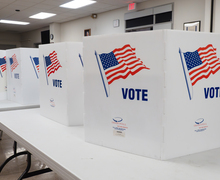As advocates lobby to bring Uber to Syracuse, critics express concern over safety and insurance regulations
Devyn Passaretti | Head Illustrator
A vote on the expansion of ride-hailing services to cities such as Syracuse has been delayed as state lawmakers have decided to prioritize other issues.
Currently, those services can’t operate in Syracuse or elsewhere in the state, except for in New York City, because state law does not include ride-hailing services in its insurance regulations. Bill A.6090, which would change state law to provide insurance for those services and thus legalize them in the state, is sitting at the moment in the New York State Assembly’s Transportation Committee.
The vote on that bill — originally expected to occur last month — now might not happen until June because the assembly has prioritized the state budget, said Assemblyman John McDonald, a co-sponsor of the bill.
As the wait for the vote continues, proponents of bringing ride-hailing services to New York state have argued that the services would have positive economic effects and would increase safety by reducing drunk driving accidents.
But critics have expressed concerns that ride-hailing services wouldn’t need to play by the same rules as the taxi industry, primarily when it comes to providing workers’ compensation insurance to their drivers and administering adequate background checks and safety screeners for those drivers.
Lawmakers in the state assembly have listened to those concerns and will likely update the bill to address them, McDonald said.
“We will be reviewing and contemplating what else we should add to this before we make ride-hailing legal in New York state,” he said.
The debate over the effectiveness of Uber’s background check process was thrown into the national spotlight on Saturday, when Jason Dalton, a 45-year-old Uber driver, was suspected of shooting and killing six people in Kalamazoo, Michigan, between transporting passengers.
One passenger, Matt Mellen, told WWMT, a CBS affiliate in Michigan, that he was a passenger of Dalton’s about five hours before the first person was killed. Mellen referred a complaint to Uber because Dalton was driving 80 miles per hour and sideswiping cars — a report Uber confirmed to The Guardian.
But Uber did not review that report, according to The Guardian. An Uber spokesman told The Guardian that Uber’s safety screeners didn’t prioritize the report because it was about erratic driving rather than explicit violence.
Uber officials did not return an email requesting comment for this story.
The incident came less than two weeks after Uber announced on Feb. 11 that it agreed to settle two lawsuits and pay $28.5 million to about 25 million drivers after the lawsuits — Philliben v. Uber Technologies Inc. and Mena v. Uber Technologies Inc. — accused the company of misrepresenting its safety measures.
The Philliben lawsuit criticized Uber’s “Safe Ride Fees,” which have been used in part to support what Uber claims are “industry leading background checks.” The lawsuit pointed out that Uber does not conduct fingerprint checks of its drivers.
Uber announced in the Feb. 11 statement that it was renaming the “Safe Ride Fee” a “Booking Fee.” But in a statement Monday, Uber maintained its criticism of the practice of fingerprinting, according to The Boston Globe.

Illustration by Dani Pendergast
Mark Ilacqua, the president of Suburban Taxi in Syracuse, said in an email that all of Suburban’s drivers are required to be fingerprinted.
Separate from the Philliben and Mena lawsuits, San Francisco District Attorney George Gascón and Los Angeles District Attorney Jackie Lacey filed a similar lawsuit in December 2014, and Gascón said in August 2015 that they found “systemic failures in Uber’s background checks,” according to sfgate.com. That lawsuit is still pending.
The website whosdrivingyou.org, a site that aims to highlight “the risks of Uber and Lyft,” has documented more than 100 total cases of deaths, assaults, kidnappings, committed felonies, DUIs and other incidents that it attributes to Uber and Lyft drivers.
Dean Baker, co-director of the Center for Economic and Policy Research in Washington, D.C. and an Uber critic, said Uber generally avoids the same strict regulations that taxi industries must adhere to.
“Uber’s strategy is to say, ‘We’re Uber, we don’t give a damn,’” Baker said. “… But there are legitimate public interests in ensuring that drivers are competent, that they don’t pose a threat to passengers.”
McDonald said he supports strict background checks for ride-hailing service drivers. He added that the state assembly will attempt to determine the best way to enforce those checks.
We’ll need to make the services compliant... If a conviction of some sort came across that would trigger their inability to drive, there needs to be a process to follow up on that.Assemblyman John McDonald
In addition, Ilacqua, the president of Suburban Taxi, said if ride-hailing services were to operate in New York state, companies such as Uber and Lyft should have to supply their drivers with auto insurance and workers’ compensation, a type of insurance that provides workers with wage replacements in the case of work-related injuries.
Lyft and Uber do not provide their drivers with workers’ compensation, according to Forbes, since its drivers are considered independent contractors. But in New York state, taxi companies pay most of their drivers workers’ compensation, according to the state’s website.
“The insurance costs alone for operating a for-hire taxi can be upwards of ($8,000-10,000) per vehicle for for-hire auto coverage and workers’ compensation,” Ilacqua said. “Any changes in the state transportation laws for Uber & Lyft must also apply to all existing for-hire transportation companies.”
Syracuse University Student Association President Aysha Seedat said she supports those ideas and creating a “level playing field” between ride-hailing services and the taxi industry.
This spring, Seedat will travel to Albany to lobby in support of Uber, with the intent of bringing it and other ride-hailing services, such as Lyft, to Syracuse.

Chase Guttman | Staff Photographer
Seedat, who spent much of last semester drafting a letter that was sent to the state assembly pledging SA’s support for Uber, is one of the founding members of an official Uber coalition of New Yorkers who want to see ride-hailing services brought to the state. Other members include members of the disability community, clergy members and mayors, including Syracuse Mayor Stephanie Miner.
In an email, Miner highlighted safety as a main benefit of bringing Uber to Syracuse.
“Whether it’s the grandmother who needs help getting to a doctor’s appointment, the workers who need a reliable and affordable way to get to their job, or the college students (that need) a safe ride home after a night out with friends, Uber has a lot to offer our great city,” she said.
SA’s letter to the state assembly cited a report conducted in January 2015 by Temple University Professors Brad Greenwood and Sunil Wattal, who found a “significant drop” in the rate of alcohol-related motor vehicle homicides from 2009-14 after Uber was introduced in 14 California counties.
The study found that Uber reduced drunk driving-related deaths by between 3.6 and 5.6 percent in the state of California.
Adding to that potential benefit, Alfonso Flores-Lagunes and Chung-Chin Liu — both economics professors at SU — each said Uber would benefit the Syracuse economy.
Flores-Lagunes said introducing ride-hailing services would create an efficient market that would increase demand for transportation services because the ride-hailing services would be more reliable than taxis.
“Imagine the following scenario: You are thinking about going out. In principle, you don’t want to use your own car, but you know that right now you need to call the cab company,” he said.
“You might not get the cab for a while, and so you decide to take the car. So that is one transaction that did not happen because the system is not as efficient as it could be,” he continued. “In the other scenario with Uber around, you know it is more convenient and it is more efficiently provided, then you would be taking an Uber to your destination.”
Flores-Lagunes said some taxi companies will inevitably have to lay off workers and some companies might go out of business, but he added that the net impact will be positive because of the increase in demand and the jobs that ride-hailing services would create. Uber estimates that in the first year of operating in Syracuse, 700 jobs will be created as a result of ride-hailing services, according to a report from the company.
Liu said the taxi companies would also likely become more efficient because the competition would force them to do so.
Right now, because there’s no competition, there’s no incentive to innovate. I think the threat of Uber would cause some of them to innovate.Chung-Chin Liu
Seedat said she will highlight those factors and the potential to reduce drunk driving accidents when she lobbies in Albany. Her purpose of being there, she said, will be to offer the student perspective on the issue.
McDonald said because the bill has been designated as a post-budget item, he’s not worried about its delayed progress in the assembly.
“If this conversation were had in May, I’d be worried, but it’s early,” he said.
McDonald added that he expects the bill to ultimately be passed and go into effect some time this year.
“We recognize that there is need, and there’s also an opportunity,” he said. “And we’re trying to do it fairly.”
Published on February 24, 2016 at 12:28 am
Contact Michael: mdburk01@syr.edu





